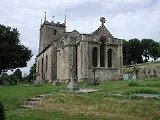
Church of St Leonard, Marston Bigot
Encyclopedia
The Church of St Leonard in Marston Bigot
, Somerset
, England was built on the site of an older one and was opened to the public in 1789. It has been designated as a Grade I listed building.
It is dedicated to Leonard of Noblac
.
The nave
has three bays with semi-circular headed windows with heavily enriched surrounds and an elaborate hammerbeam roof
. The stained glass in the east window dates from the 15th century and is from the abbey of Altenberg
near Cologne
, Germany
. It depicts a scene from the early life of St Bernard
, the driving force of the Cistercian order.
It has a tower containing a peal of six bells.
The church was altered in 1844 by Edward Davis.
Henry Waldegrave, 11th Earl Waldegrave
, was rector
of the village from 1905–12, and lived in the rectory, which is also a listed building.
Marston Bigot
Marston Bigot is a small village near Nunney and south of Frome in Somerset, England.-History:Marston Bigot was listed as "Mersitone-tora" in the Doomesday Book, which gave the name of the then Saxon landowner as Robert Arundel. It became known as Marston Bigot some time after it was given by...
, Somerset
Somerset
The ceremonial and non-metropolitan county of Somerset in South West England borders Bristol and Gloucestershire to the north, Wiltshire to the east, Dorset to the south-east, and Devon to the south-west. It is partly bounded to the north and west by the Bristol Channel and the estuary of the...
, England was built on the site of an older one and was opened to the public in 1789. It has been designated as a Grade I listed building.
It is dedicated to Leonard of Noblac
Leonard of Noblac
Leonard of Noblac or of Limoges or de Noblet , is a Frankish saint closely associated with the town and abbey of Saint-Léonard-de-Noblat, in Haute-Vienne, in the Limousin of France.-Traditional biography:According to the romance that...
.
The nave
Nave
In Romanesque and Gothic Christian abbey, cathedral basilica and church architecture, the nave is the central approach to the high altar, the main body of the church. "Nave" was probably suggested by the keel shape of its vaulting...
has three bays with semi-circular headed windows with heavily enriched surrounds and an elaborate hammerbeam roof
Hammerbeam roof
Hammerbeam roof, in architecture, is the name given to an open timber roof, typical of English Gothic architecture, using short beams projecting from the wall.- Design :...
. The stained glass in the east window dates from the 15th century and is from the abbey of Altenberg
Altenberg, Germany
Altenberg is a town in the Sächsische Schweiz-Osterzgebirge district, in the Free State of Saxony, Germany. It is situated in the Ore Mountains, close to the border with the Czech Republic, 15 km northwest of Teplice, and 32 km south of Dresden....
near Cologne
Cologne
Cologne is Germany's fourth-largest city , and is the largest city both in the Germany Federal State of North Rhine-Westphalia and within the Rhine-Ruhr Metropolitan Area, one of the major European metropolitan areas with more than ten million inhabitants.Cologne is located on both sides of the...
, Germany
Germany
Germany , officially the Federal Republic of Germany , is a federal parliamentary republic in Europe. The country consists of 16 states while the capital and largest city is Berlin. Germany covers an area of 357,021 km2 and has a largely temperate seasonal climate...
. It depicts a scene from the early life of St Bernard
Bernard of Clairvaux
Bernard of Clairvaux, O.Cist was a French abbot and the primary builder of the reforming Cistercian order.After the death of his mother, Bernard sought admission into the Cistercian order. Three years later, he was sent to found a new abbey at an isolated clearing in a glen known as the Val...
, the driving force of the Cistercian order.
It has a tower containing a peal of six bells.
The church was altered in 1844 by Edward Davis.
Henry Waldegrave, 11th Earl Waldegrave
Henry Waldegrave, 11th Earl Waldegrave
Henry Noel Waldegrave, 11th Earl Waldegrave was a British peer and minister of religion.Waldegrave was born in 1854, the posthumous son of William Waldegrave, Viscount Chewton and his wife Frances. He was educated at Eton and graduated from Trinity College, Cambridge in 1878...
, was rector
Rector
The word rector has a number of different meanings; it is widely used to refer to an academic, religious or political administrator...
of the village from 1905–12, and lived in the rectory, which is also a listed building.

